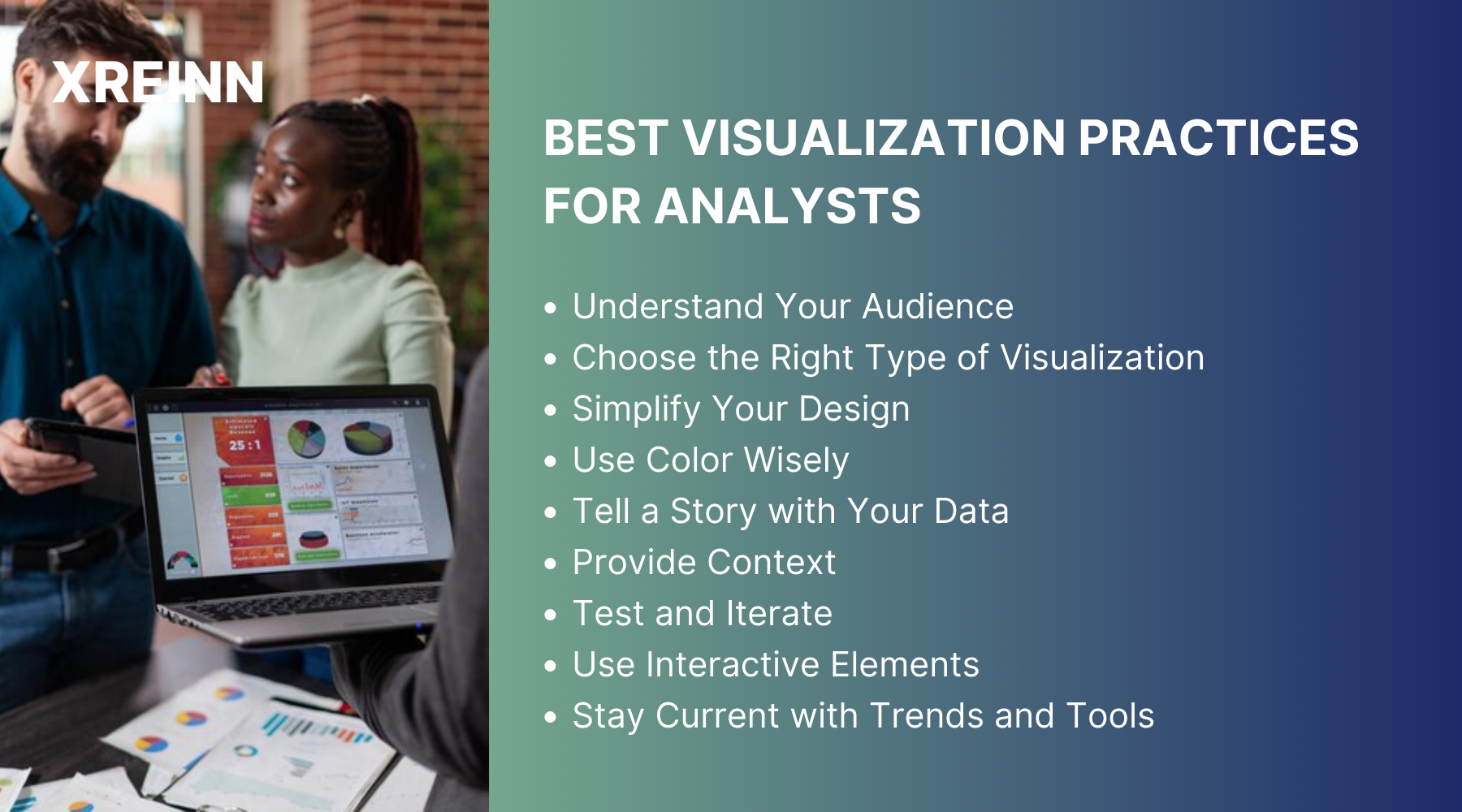Data Analytics
Improve Your Data Expertise: Top Visualization Techniques for Analysts
Jul 08, 2024
Presenting data effectively is very important in the data analytics process. As an analyst, you convert raw data into clear, compelling visual stories that greatly influence your organization. This skill helps make informed decisions, drives growth, and improves performance. By mastering data visualization, you ensure your insights are easily understood and actionable, making a significant impact on your company's success
This is especially important for all businesses that are aiming to make informed decisions. Data visualization can help your organization drive growth, improve operations, and improve customer satisfaction.
In this article, you will learn how to use best practices to maximize your design's impact, such as understanding your audience, selecting the right visualization types, and simplifying it.
Best Visualization Practices for Analysts

Understand Your Audience
Knowing your audience is the first step in creating effective data visualizations. Are you presenting to executives who need high-level summaries, or to technical staff who require detailed insights?
You can make your data more impactful and accessible by customizing your visualizations to meet the needs and preferences of your audience.
For example, executives often prefer visualizations that highlight key metrics and trends, allowing them to make quick, informed decisions. On the other hand, technical staff might appreciate more detailed visualizations that enable deeper analysis. Understanding these nuances ensures your data speaks directly to those who need it most.
Choose the Right Type of Visualization
Selecting the right type of visualization is crucial to effectively convey your message. Here are some common types and their best use cases.
- Bar Charts: Excellent for comparing quantities across different categories.
- Line Charts: Ideal for showing trends over time.
- Pie Charts: Useful for illustrating proportions and percentages.
- Scatter Plots: Perfect for highlighting correlations between variables.
- Heat Maps: Effective for showing data density and patterns.
Each type of visualization has its strengths and weaknesses. For instance, while pie charts are great for showing proportions, they can become confusing with too many segments. Choose the visualization that best represents your data and supports your message.
Simplify Your Design
When it comes to data visualization, simplicity is key. A cluttered design can overwhelm your audience and obscure the main message. Clean, simple designs enhance the visual appeal of your visualizations as well as their comprehension. Here are some tips to keep your visualizations simple yet effective:
- Limit Colors: Use a restricted color palette to avoid visual overload.
- Remove Unnecessary Elements: Eliminate gridlines, borders, and other non-essential elements that can distract from the data.
- Use Clear Labels: Ensure that all axes, titles, and data points are clearly labeled for easy interpretation.
Use Color Wisely
Color can significantly enhance the effectiveness of your data visualization, but it must be used wisely. Proper use of color can make your data stand out and convey your message more powerfully. Here are some best practices for using color:
- Highlight Key Data: Use contrasting colors to draw attention to important data points.
- Maintain Consistency: Use the same colors for similar data points across different visualizations to avoid confusion.
- Consider Color Blindness: Choose color schemes that are accessible to individuals with color vision deficiencies, ensuring your visualizations are inclusive.
Tell a Story with Your Data
Data visualization is not just about presenting numbers; it's about telling a story. A well-crafted narrative guides your audience through the data, highlighting key insights and trends. This storytelling approach makes your data more engaging and memorable.
For example, instead of just showing a line chart of sales over time, you can narrate the story of how a particular marketing campaign led to a spike in sales. Providing this context helps your audience understand the significance of the data and its implications.
Provide Context
Context is crucial for interpreting data correctly. Without context, your audience might misinterpret the visualizations. Always provide enough context to make your visualizations understandable.
Providing context ensures that your audience grasps the full meaning of your data visualizations. This includes:
- Titles and Subtitles: Clearly state what the visualization is about.
- Annotations: Use annotations to highlight significant data points or trends.
- Sources: Cite data sources to establish credibility and allow for further exploration.
Test and Iterate
Creating effective data visualizations is an iterative process. Test your visualizations with a small audience to gather feedback and identify areas for improvement. Be open to making changes based on this feedback to enhance clarity and impact.
For example, you might find that certain colors are confusing to your audience or that some data points need more explanation. Iterating based on feedback helps you refine your visualizations to better meet the needs of your audience.
Use Interactive Elements
Interactive visualizations can greatly enhance user engagement and understanding. Consider incorporating interactive elements such as filters, tooltips, and drill-down capabilities. These features allow users to explore the data on their own and gain insights that are most relevant to them.
Interactive visualizations can transform a static presentation into a dynamic exploration, providing a richer, more personalized experience for your audience.
Stay Current with Trends and Tools
The field of data visualization is constantly evolving, with new tools and techniques emerging regularly. Staying current with the latest trends and technologies can help you create more dynamic and effective visualizations.
Popular tools like Tableau, Power BI, and D3.js offer powerful capabilities for creating interactive and visually appealing data visualizations. By keeping up with advancements in the field, you can leverage these tools to enhance your data storytelling.
Conclusion
Mastering data visualization is essential for analysts who want to make a significant impact with their work. By understanding your audience, choosing the right type of visualization, simplifying your design, using color wisely, telling a story, providing context, testing and iterating, incorporating interactive elements, and staying current with trends, you can create visualizations that not only convey your insights effectively but also inspire action.
Effective data visualization is about making data understandable and actionable. By following these best practices, you can transform your data into a powerful tool for communication and decision-making, helping SMEs thrive in today's competitive landscape. Start applying these principles today and watch your data come to life in ways you never imagined.

Data Analytics
Jun 27, 2024Master key concepts in data analytics with practical tips to enhance decision-making and achieve success in your projects and professional growth

Data Analytics
Jul 01, 2024Learn the essential stages of the data analytics workflow to turn your data into valuable business insights and drive growth.

